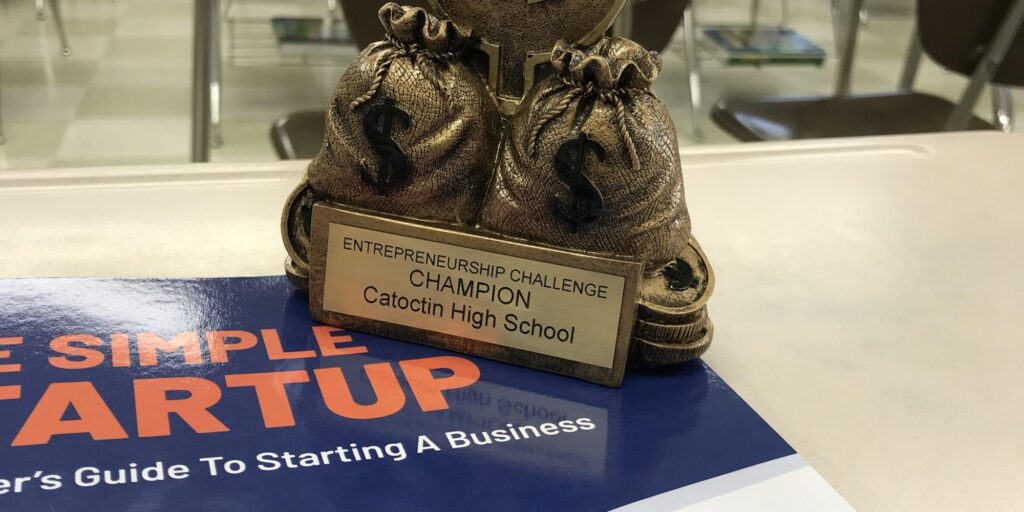The best part about running The Simple StartUp project is getting to see everyone’s hard work.
One of the most rewarding moments I’ve had recently was getting an email from a student who was a senior last year. He wrote to let me know that he was loving life in college and had continued his Simple StartUp from high school down there. He talked about how he was applying what he learned in our club to build his personal brand and network with his peers and professors. I can’t tell you how proud this made me and I immediately invited him to come speak to my class whenever he was back in town. I’m really looking forward to the end of this pandemic shutdown just to have him come in and share his inspiring experiences with my current crop of students!
While there are many ways to showcase everyone’s work, I’m going to dive deep into three methods that have proven successful in the past:
- The Business Fair
- The Pitch Competition
- The Showcase Advertisement
Each one has different needs in terms of space, time, technology, and cost to run. You could do one of these, or several if you want to give lots of opportunities for your students to shine.
The Business Fair
In the Business Fair, all businesses have a stall where they can display their business and potentially sell to the public.
An ideal space for this is a school gymnasium, cafeteria, or other large open space. If your school has a “loop” setup where hallways are connected in a circuit, you could also set up stalls on one side of the hallway around the loop.
If you are planning to set up your business fair during the school day, this could cause some disruption to classes, so keep that in mind when planning your event.
Materials Needed
For this event, each student will need a table or to create their own stall for their business.
Encourage students to personalize and get creative with the appearance of their stall since this will act as their “shop front” and will be the first impression of the business. Invite students to have products to sell or demonstrations of their services available with the ability to take bookings.
How To Run
You can opt to run this event after school, on a weekend, or during the school day.
It will probably be unique to your situation and what kind of response you would expect from your community. Invite the rest of the student body, teachers, parents, local businesses, local politicians, and news media to come see what your students have created.
Ensure that your students are prepared with pitches and are ready to explain their businesses. Have the students set up and ready to go before letting the public in.
Judging
We’ve created a sample judging rubric in the Resources section of The Simple StartUp website which you can give to a panel of judges. You can download that here.
Include other staff, students, local business owners, and administration to make up a diverse judging panel. Give time for judges to walk around to each of the businesses and interview the owners about their Simple StartUps.
At the end, take the scores from the judges and use those to determine your winning business.
The Pitch Competition
Have you ever watched an episode of the business pitch show, Shark Tank? Entrepreneurs looking for investor funding come onto the show and pitch their idea or existing business to investors, with the aim of trying to get them to invest in their company to allow it to start or grow.
A Simple StartUp should not require an investor or capital to get started, but the idea of pitching the business to a panel of judges does work well in this case.
Materials Needed
Use an auditorium stage or find a space where students can be in front of a panel of judges, and ideally with access to a projector screen.
Allow students to have a slideshow to accompany their presentation but also encourage them to have samples of products and demonstrations of services where possible,
How To Run
Invite the rest of the class, or school, to watch the competition and see the amazing work your students have done.
Give Simple StartUp teams a fixed time limit (5-10 minutes is ideal) to present their business and then take questions from the judges.
Judging
Create a small panel of judges made up of people such as teachers, other students (maybe class presidents), administration, local business owners, a sponsor business representative, a city or town representative who works in an area of supporting new and small businesses, etc.
Give each judge a scoring rubric and suggested questions guide, such as the one provided in the Instructor Edition of the workbook or the Resources section of The Simple StartUp website.
The team with the highest average score is the winner.
The Showcase Advertisement
At some point, I’m sure you have had to help your school, student, community organization, or business win a prize by voting for them online. If not, what happens is all contestants for a prize will post a story, video, or picture which is vying for your vote.
We will use the same idea here where we will let the public vote for their favorite Simple StartUp through an online forum.
Materials Needed
You will need to create a basic website where each business team can have a profile section.
Each business will submit some form of advertisement of their business which clearly explains who they are and what they provide. It can be written, video, picture, audio, etc. You determine what kind of final product you want from students.
How To Run
Once all teams have submitted their advertisement to you, post them on the website.
Create a google form to accompany the website, or if you are up to the challenge, figure out how to create a poll embedded within your site! Determine a window of time for voting to take place and release the information to the public.
Encourage students to share the site as far and wide as they can to try and pick up votes.
Judging
While this method may lead to the greatest geographic and numerical reach for your project, it can often turn into a popularity contest instead of a true measure of the “best” business.
The team with the highest number of votes would be the winner.
Do We Need A Winner?
Having a winner is a totally optional thing to do.
In some school districts and states, there are opportunities to have student teams enter entrepreneurship competitions to compete for prizes.
Here are two examples of contests:
Your school competition can act as the first round of that process where you select a team to represent your school in a larger competition. If there isn’t one already, consider setting one up for your area!
Creating a culminating event where the Simple StartUps have a stage to showcase their hard work is the real goal here. By having a final event, this often acts as your assessment for the project too and gives students the goal they need for getting their businesses up, running, and aesthetically polished by a given date.
The fun part is you can turn that into whatever you like!
As always please don’t forget to share your culminating events on www.thesimplestartup.com/stories or tag The Simple StartUp on Twitter and Facebook.


